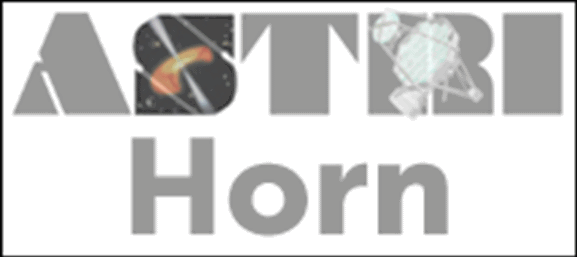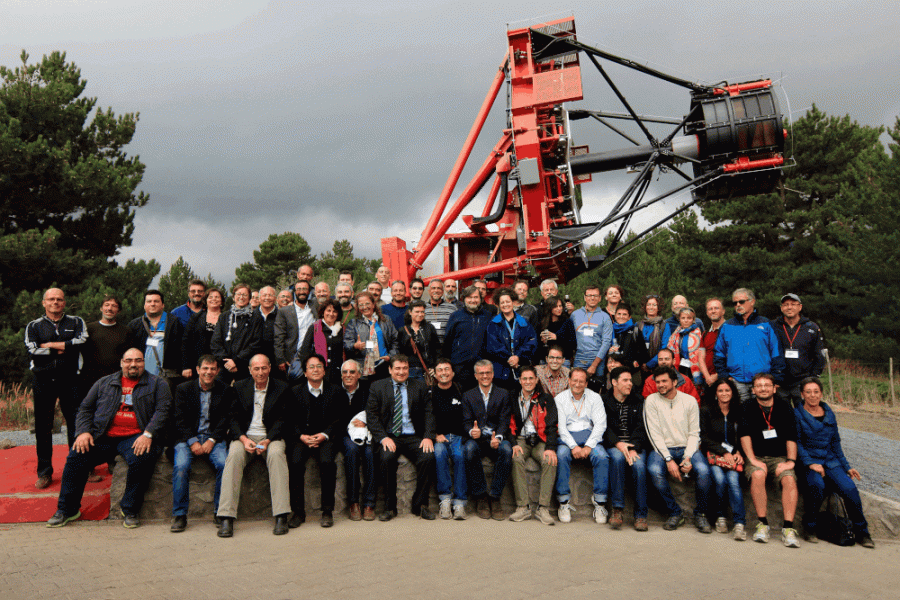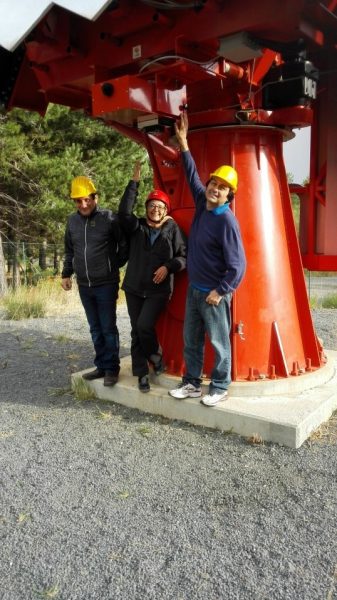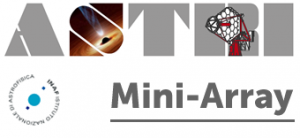The ASTRI telescopes: from the prototype to the mini-array
The ASTRI (“Astrofisica con Specchi a Tecnologia Replicante Italiana”) Project developed a technologically innovative solution for small size (about 4 meters diameter) and large field-of-view (more than 10 degrees) Image Atmospheric Cherenkov Telescopes (IACT). A prototype telescope, deployed on Mt. Etna (Italy), started its scientific operations in 2018. The current aim of the project is the deployment of a mini-array of 9 ASTRI telescopes at the Teide Observatory (Canary Islands, Spain) which will perform deep observations of the galactic and extragalactic sky at multi-TeV energies with an unprecedented sensitivity with respect to current IACT arrays.
The ASTRI telescopes
The ASTRI telescopes present several innovative technological solutions for the detection of atmospheric Cherenkov light. From a general point of view, like every IACT telescope, they have a mount that allow them to rapidly point towards targets and are comprised of a segmented collecting mirror system to reflect the Cherenkov light to a high-speed camera that can digitize and record the image of the shower.
What are then the innovations? First of all, the optical system that implements, for the first time, the double mirror Schwarzschild-Couder (SC) configuration. The 4.3 m diameter primary mirror is composed of an array of hexagonal tiles while the secondary mirror, 1.8 m diameter, is a monolithic hemispherical thick glass shell thermally bent to 2.2 m radius of curvature. The telescope equivalent focal length is 2.15 m, f/0.5, and the system covers a full field-of-view (FoV) of more than 10°.
The double mirror SC configuration results in a small plate scale (37.5 mm/deg), leading to a camera of compact dimension. Having typical lateral dimension of few millimeters, the silicon photomultipliers (SiPM) sensors are the perfect solution to realize such a compact Cherenkov camera with large FoV. Assembled without any light collection system onto the ASTRI curved focal plane located between the two mirrors, the SiPMs act as the camera pixels. In the ASTRI camera the SiPM sensors are organized in 37 Photon Detection Modules (PDM) of 8×8 pixels, each of them with a sky-projected angular size of 0.19°, matching the angular resolution of the optical system. This configuration yields a Point Spread Function (PSF), defined as the 80% of the light collected from a point like source, contained in less than one camera pixel.
The SiPM sensors exhibit very fast response and excellent single photoelectron resolution. They need a properly tailored electronics devoted to directly interface the SiPM sensors, detecting the fast pulses produced by the Cherenkov flashes, managing the trigger generation, the digital conversion of the signals and the transmission of the data to the camera server external to the telescope. The ASTRI camera electronics is based on a custom peak-detector operation mode to acquire the SiPM pulses. The Cherenkov Imaging Telescope Integrated Read Out Chip (CITIROC), with its signal shaper and peak detector properly customized for ASTRI, represents an innovative technical solution and provides high efficiency pixel by pixel trigger capability and very fast camera pixel read-out.
The ASTRI camera trigger is a topological one, activated when a given number of contiguous pixels within a PDM presents a signal above a given photo-electron threshold. Both the number of contiguous pixels required for a trigger and the signal threshold can be manually set or automatically adjusted, depending on the level of night sky background. Data registered by the ASTRI camera at the occurrence of a trigger condition (scientific raw event) or when required (calibration or housekeeping data) are then sent to the camera server in which the camera data acquisition software is installed.
To complete this general overview, it is worth to mention that the ASTRI focal plane is covered by a protective window and the entire camera, with its electronics and all ancillary devices, is closed in a basket whose top is open thanks to a lid system. A novel inner fiber-optic equipment for relative calibration, and a GPS receiver used for time synchronization and providing tag-time for triggered events, are part of the camera ancillary devices. Moreover, a Pointing Monitoring Camera (PMC) and a Sky Quality Meter (SQM) are installed on the rear of the secondary mirror support structure. The PMC is used to obtain astrometric calibrated FoV of the region pointed to by the telescope; the SQM provides a quick evaluation of the night sky brightness in a region 10 degrees around the telescope pointing.

ASTRI-Horn, the prototype
The ASTRI telescope prototype has been developed by INAF following an end-to-end approach that comprises all aspects from the design, construction and implementation of the entire hardware and software system to the final scientific products. In this respect, the internal and external calibration systems, control/acquisition hardware and software, data reduction and analysis software, data archiving system and data center have been realized in addition to the telescope structure and camera.
The prototype, with its control room, is installed in Italy at the INAF “M.C. Fracastoro” observing station located in Serra La Nave (Mt. Etna, Sicily), 1740 m a.s.l. and equipped with weather station and all sky camera devoted to the monitoring of meteorological and environmental conditions.


The optical validation of the Schwarzschild Couder dual-mirror design of the ASTRI prototype was achieved in October 2016; this accomplishment was the first optical demonstration for astronomical telescopes using such a design (INAF Press Release_ASTRI_optics, CTA Press Release_ASTRI_optics).
During the nights of 25 and 26 May 2017, the camera of the ASTRI telescope prototype recorded its first ever Cherenkov light while undergoing technical testing. Although the camera was not yet fully configured (only few PDMs were active), the ASTRI team was still able to capture its first Cherenkov light and produce beautiful images of the showers generated by cosmic rays in the Earth’s atmosphere (INAF Press Release_ASTRI_First_Light, CTA Press Release_ASTRI_First_Light).


In parallel to its normal activity of revealing gamma events through the emitted Cherenkov light, the ASTRI camera is also able to produce images of the night sky (generated by the stars and the diffused sky background) using the method of variance based on the statistical analysis of the variability of the signal detected in the camera electronics.
The Belt of Orion provided us is the first example of night sky image obtained by analyzing the ASTRI camera variance data, January 2018 (INAF Press Release_ASTRI_Variance_Orion_Belt).


In June 2018 the UVscope instrument becomes operative (Experimental Astronomy, 51-2021). Placed onto the ASTRI primary mirror support and co-axial to the telescope, this auxiliary instrument is devoted to the monitoring of the diffuse night sky background within the central part of the region pointed to by ASTRI and it is also used as further diagnostic tool for the ASTRI camera and optics performance
On 10 November 2018, following a proposal of the Italian Astronomical Society (SAIt), INAF dedicated the ASTRI prototype to Guido Horn d’Arturo, the Italian astronomer who first conceived and realized a telescope with a large mirror made of segments. Since then, ASTRI-Horn is the official name of the ASTRI telescope prototype installed at the Serra La Nave site.


During December 2018 and January 2019, ASTRI-Horn observed the Crab Nebula region for a total time of 29 hours. The camera was still not fully operational (only 21 PDMs on 37 were active); moreover recent volcanic activity events had degraded the mirror reflectivity. Despite these limitations, the Crab Nebula was detected with high significance, down to an energy threshold of 3.5 TeV. (INAF press release, CTA press release) definitively demonstrating the effectiveness of the ASTRI-Horn telescope (double mirror, SiPM camera, CITIROC electronics) and opening a new era for gamma-ray astronomy with the Cherenkov technique.
After refurbishment and optimization of some its components, ASTRI-Horn is newly acquiring data for several
purposes since winter 2022. The experience acquired with ASTRI-Horn led to the second phase of the ASTRI Project: to build and operate the ASTRI Mini-Array.

ASTRI Mini-Array, the mini-array of ASTRI telescopes
The ASTRI Mini-Array is an international project, led by INAF, aiming to build and operate an observatory to study astronomical sources emitting at very high-energy in the TeV spectral band. The ASTRI Mini-Array consists of nine identical ASTRI telescopes that will be installed at the Teide Astronomical Observatory of the Instituto de Astrofisica de Canarias (IAC) in Tenerife (Canary Islands, Spain) on the basis of a host agreement with INAF.
The design of the ASTRI Mini-Array telescopes is an evolution of ASTRI-Horn. The telescopes structure has been lightened reducing the number of the masts and maintaining the same stiffness, while the coating of the mirrors will be optimized even in function of the material used for the camera protection window. The telescope design implements a larger field of view (more than 10 deg in diameter). New SiPM sensors will be adopted (in the prototype, the LCT5 model by Hamamatsu is used) and the capabilities of the CITIROC ASIC, developed by Weeroc in collaboration with INAF, in the camera electronics will be upgraded to take into account the time tag of all triggered pixels. In any case, the telescopes for the ASTRI Mini-Array will follow the design philosophy previously described. Same consideration for what concerns the camera servers whose prototype has been already designed in view of the mini-array configuration. In this case, the camera servers (one for each telescope), in addition to acquiring data without loss as for the prototype, have to interface with the array trigger, clock distribution, array control and data acquisition systems. Furthermore, the Information and Communication Technologies (ICT) architecture designed for the prototype will be scaled up, taking into account the necessary control, monitor and alarm system requirements. Eventually, data model, analysis pipeline and archive developed for the prototype are already designed in view of the ASTRI Mini-Array configuration.
Last but not least, in order to simplify the site infrastructure design, reduce operation, maintenance and personnel costs, the ASTRI Mini-Array telescopes are being designed to be operated in fully automatic mode with remote supervision.
Thanks to its expected overall performance, better than current Cherenkov telescopes’ arrays for energies above about 5 TeV and up to 100 TeV and beyond, the ASTRI Mini-Array will represent an important instrument to perform deep observations of the Galactic and extra-Galactic sky at these energies. Important synergy with already existing IACT and Water Cherenkov facilities in both the northern and southern hemisphere are also foreseen. The ASTRI Mini-Array will also pave the way to the highest energies observations to be done with CTA at its southern site.
The ASTRI Mini-Array operation phase consists of two distinct periods: during the first three years the system will carry out dedicated science programs defined by the ASTRI Science Team, then the system will also be partially open to execute observing programs proposed by the science community. Besides gamma-ray scientific program, the ASTRI Mini-Array will allow to perform optical intensity interferometric observations of bright stars.
Read more on the ASTRI official site.
To read ASTRI publications click here.